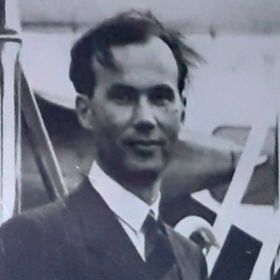A Co Antrim scientist who was recruited by the United States to play a part in the development of the atomic bomb during the Second World War is to be commemorated with an Ulster History Circle Blue Plaque in his home village.
James Sayers joined a team in the Radiation Lab at Berkeley, California, where he was added to the top-secret Manhattan Project.
His earlier wartime work for the Admiralty led to the development of radar which helped the Allies win the Battle of the Atlantic.
The same technology he had pioneered was later used in developing the domestic microwave oven.
After the war Sayers helped develop the UK’s first space programme and worked with Nasa, then newly established.
Sayers was born at Corkey, Loughgiel, Co Antrim, on September 2, 1912. His sister Dorothy later became a teacher in Ballycastle High School, while his brother John carried on the family farming tradition.
The Sayers also ran the local post office in Corkey. James Sayers was more interested in science, but he did build a waterwheel on a river to power a dynamo and supply the farm with electricity.
He went to Ballymena Academy, then studied physics at Queen’s, before doing research at St John’s College Cambridge.
At the approach of war, he was recruited by the Admiralty to work on radar in the University of Birmingham.
He was single-handedly responsible for the most important technological breakthrough in the early years of the war.
It enabled radar to pick out even the gun barrels or periscopes on its targets and secured victory for the Allies in the crucial Battle of the Atlantic.
Later, this magnetron technology was used to develop the domestic microwave oven.
In 1943, Sayers joined a team of British scientists working on the Manhattan Project to develop the atomic bomb after being recruited by Mark Oliphant, with whom he’d worked at Birmingham University.
Physicist James Sayers
Oliphant led the scientists developing electromagnetic uranium enrichment – a crucial but less overtly military part of the project.
Sayers was professor of electron physics in Birmingham until 1972 and in 1955 had been a founding member of a group set up by the Royal Society to carry out research on the upper atmosphere.
There, with the British National Committee on Space Research, he devised experiments to travel on specially designed rockets at what was the start of the UK space programme.
The first Skylark rocket was launched from Woomera Australia in 1957. It carried a probe from Sayers’ team to measure electron density in the atmosphere. Later, Sayers helped negotiate with Nasa on the first international space project.
In his later years, James returned to his roots when he bought back the family farm in Corkey, Co Antrim, and lived quietly there in his retirement until his death on March 13, 1993.
The Rev Robert Hanna, who grew up near the Sayers family, will be among those attending the unveiling of the plaque.
“In early life, James Sayers was a neighbour of mine in Corkey,” he said. “I have long felt he should be recognised. I’m delighted this will now be the case.”
Chris Spurr, chairman of the Ulster History Circle, said it was fitting to commemorate a Northern Ireland man who had made such a wide-ranging contribution to the world of scientific discovery.
“James Sayers was a pioneering physicist whose discoveries in the fields of radar and microwave technology have changed the world,” he said.
“The Ulster History Circle is delighted to commemorate this eminent scientist with a blue plaque on the former National School at Ballyweaney.
“The Circle is grateful to Causeway Coast and Glens Borough Council for their financial support towards the plaque, and to Ballyweaney Presbyterian Church and the Rev Robert Hanna for their kind assistance.”
The plaque to Sayers will be unveiled at the former National School close to Ballyweaney Presbyterian Church near Cloughmills at 2pm on Thursday.
The Ulster History Circle places blue plaques across the nine counties of Ulster, to celebrate the achievements of those men and women who have contributed significantly to our history, locally, nationally and internationally and is the only organisation of its kind in Ireland.
